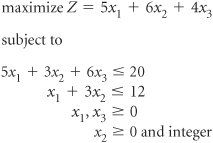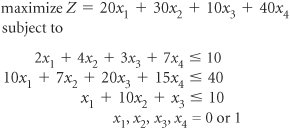| 1. | Consider the following linear programming model  -
[Page C-12] -
Solve this model using the branch and bound method. -
Demonstrate the solution partitioning graphically. |
| 2. | Solve the following linear programming model using the branch and bound method.  |
| 3. | A tailor makes wool tweed sport coats and wool slacks. He is able to get a shipment of 150 square yards of wool cloth from Scotland each month to make coats and slacks, and he has 200 hours of his own labor to make them each month. A coat requires 3 square yards of wool and 10 hours to make, and a pair of pants requires 5 square yards of wool and 4 hours to make. He earns $50 in profit from each coat he makes and $40 from each pair of slacks. He wants to know how many coats and slacks to produce to maximize profit. -
Formulate an integer linear programming model for this problem. -
Determine the integer solution to this problem using the branch and bound method. Compare this solution with the solution without integer restrictions and indicate if the rounded-down solution would have been optimal. |
| 4. | A jeweler and her apprentice make silver pins and necklaces by hand. Each week they have 80 hours of labor and 36 ounces of silver available. It requires 8 hours of labor and 2 ounces of silver to make a pin, and 10 hours of labor and 6 ounces of silver to make a necklace. Each pin also contains a small gem of some kind. The demand for pins is no more than six per week. A pin earns the jeweler $400 in profit, and a necklace earns $100. The jeweler wants to know how many of each item to make each week in order to maximize profit. -
Formulate an integer programming model for this problem. -
Solve this model using the branch and bound method. Compare this solution with the solution without integer restrictions and indicate if the rounded-down solution would have been optimal. |
| 5. | A glassblower makes glass decanters and glass trays on a weekly basis. Each item requires 1 pound of glass, and the glassblower has 15 pounds of glass available every week. A glass decanter requires 4 hours of labor, a glass tray requires only 1 hour of labor, and the glassblower works 25 hours a week. The profit from a decanter is $50, and the profit from a tray is $10. The glassblower wants to determine the total number of decanters ( x 1 ) and trays ( x 2 ) that he needs to produce in order to maximize his profit. -
Formulate an integer programming model for this problem. -
Solve this model using the branch and bound method. -
Demonstrate the solution partitioning graphically. |
| 6. | The Livewright Medical Supplies Company has a total of 12 salespeople it wants to assign to three regions the South, the East, and the Midwest. A salesperson in the South earns $600 in profit per month for the company, a salesperson in the East earns $540, and a salesperson in the Midwest earns $375. The southern region can have a maximum assignment of 5 salespeople. The company has a total of $750 per day available for expenses for all 12 salespeople. A salesperson in the South has average expenses of $80 per day, a salesperson in the East has average expenses of $70 per day, and a salesperson in the Midwest has average daily expenses of $50. The company wants to determine the number of salespeople to assign to each region to maximize profit.
[Page C-13] -
Formulate an integer programming model for this problem. -
Solve this model using the branch and bound method. |
| 7. | Helen Holmes makes pottery by hand in her basement . She has 20 hours available each week to make bowls and vases. A bowl requires 3 hours of labor, and a vase requires 2 hours of labor. It requires 2 pounds of special clay to make a bowl and 5 pounds to produce a vase; she is able to acquire 35 pounds of clay per week. She sells her bowls for $50 and her vases for $40. She wants to know how many of each item to make each week in order to maximize her revenue. -
Formulate an integer programming model for this problem. -
Solve this model using the branch and bound method. Compare this solution with the solution with integer restrictions and indicate if the rounded-down solution would have been optimal. |
| 8. | Lauren Moore has sold her business for $500,000 and wants to invest in condominium units (which she intends to rent) and land (which she will lease to a farmer). She estimates that she will receive an annual return of $8,000 for each condominium and $6,000 for each acre of land. A condominium unit costs $70,000, and land is $30,000 per acre. A condominium will cost her $1,000 per unit and an acre of land $2,000 for maintenance and upkeep. Lauren wants to know how much to invest in condominiums and land in order to maximize her annual return. -
Formulate a mixed integer programming model for this problem. -
Solve this model using the branch and bound method. |
| 9. | The owner of the Consolidated Machine Shop has $10,000 available to purchase a lathe, a press, a grinder, or some combination thereof. The following 01 integer linear programming model has been developed for determining which of the three machines (lathe, x 1 ; press, x 2 ; grinder, x 3 ) should be purchased in order to maximize the annual profit.  Solve this model using the branch and bound method. |
| 10. | Solve the following mixed integer linear programming model using the branch and bound method.  |
| 11. | Solve problem 9 using the implicit enumeration method. |
| 12. | Consider the following linear programming model.  -
[Page C-14] -
Solve this problem using the implicit enumeration method. -
What difficulties would be encountered with the implicit enumeration method if this problem were expanded to contain five or more variables and more constraints? |